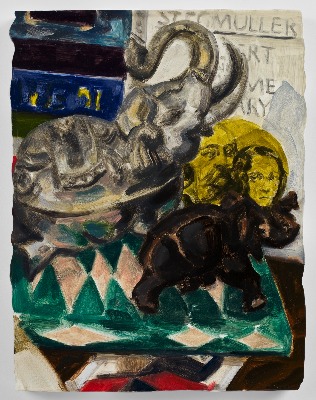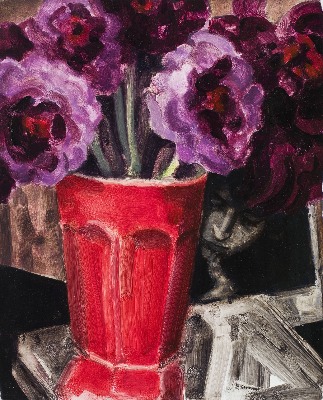The East Wing galleries of the Royal Hospital, Kilmainham, were formerly the home of army pensioners and Elizabeth Peyton’s paintings sit cosily above the fireplaces and nestle in the intimate domestic spaces more comfortably than in a white cube. Many of the works are on loan from private collections and the homely backdrop offers the viewer a glimpse at how successfully they must fit in other classically grand residences. The strength of the installation is only undermined by the accompanying text, an apologist pamphlet, striving to justify the worth of the paintings despite how comfortable they look. Ashamed equally of the subjects and of the paintings’ delicate familiarity, there appears to be some trepidation that an uninformed public will dismiss a roll-call of nineteenth- and twentieth-century celebrities. It is as unnecessary as an art historian trying to explain the worth of Boucher’s Madame de Pompadour (1759) in terms of contemporary relevance alone.

Despite the curatorial lack of confidence (whether in the paintings themselves or their audience), the acts of reading and writing evoked by Peyton’s work fold the viewer into their process: the artist’s interpretation, our own; the personal understanding and the public response; the reactive and the expressive essence of these primary functions. Flowers, books, occasional tables accompany (or, in works such as Flaubert and Madame Bovary, (Elephants), 2008, replace) the louche matinée idols on whom Peyton obsesses. Dylan, Wilde, Sorel: as tenderly sketched in paint as hearts inked across the margins of adolescent diaries. Motifs retraced and repeated, not absent-mindedly but with deliberate emphasis on the significance of the individual and the reverence in which they are held.

Romantic heroes gaze into a dreamy distance, enraptured by their own naïve idyll. Oscar and Bosie (1998), a markedly recurring pair in this Irish exhibition, are cradled in a monochrome pearlescence, ink dripping across their entwined fingers and falling across Wilde’s face as bloody tears of black. Peyton achieves subtle effects through forthright techniques – a single colour delineates the protagonists in The Age of innocence (2007) – scarlet pastel pencil on paper heightening the tormented passion of the almost-embrace in what is essentially a study of hair and shadows. Treating historical characters and fictitious icons with the same etching brushstrokes, Peyton emphasises a contemporary preoccupation with personal mythologies. Figures tainted with the same doomed innocence of the Celtic Kitten are depicted at the height of their futile hopefulness, when they most successfully capture public imagination at the careful behest of author or publicist.

Smooth cornicing and linear alcoves temper the effusive romantics with cool classicism and neatly unsettle some of the artist’s more familiar works. The pencil-on-paper Constance Wilde and son (1996) lurks in shadow around the corner from the flamboyantly lilac Bosie (1998), a large lithograph given pride of place above a stucco fireplace. Rouged cheeks, groomed brows, lined eyes and bee-stung lips, against a floral wallpaper, resonate against the maternal, diminutive Mrs Wilde. The still-lifes of generously painted objects each lead to a specific portrait, with lettering on books clearly legible, paraphernalia laden with symbolism and flowers arranged as keepsakes. Lack of ambiguity does not render the paintings simple, and the installation of Peyton’s poster-boys and -girls opens them up to fresh interpretation. Enmeshed in these unlikely rooms, the action required in re-reading her paintings subverts them from passivity as records of a sentimental past to engaging personalities of art.
Mai Blount is a post-graduate student at the Irish Art Research Centre, Trinity College Dublin.